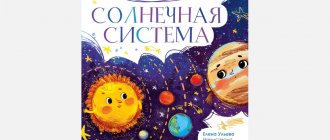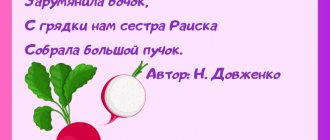Conversation “Where did the book come from?” outline of a lesson on speech development (senior group)
Conversation “Where did the book come from?”
Goal: to form in children a system of knowledge about the significance of a book as a work of aesthetic culture.
Tasks:
1. Introduce children to the birth of a book.
2. Arouse interest in reading fiction.
3. Instill in children a caring attitude toward books and respect for the work of adults.
Progress of the conversation:
I would like to start our conversation with a question:
—Where did the book come from?
You take the book and open it. Do you think about who helped her come into the world? What do you know about the author, about the artist? Who then worked on it - in the publishing house, in the huge workshops of the printing house?
Let's enter this world - the world of creativity and production.
Today we will talk about who makes books, what is needed for this, how they should be handled.
How the book is structured.
When you pick up a book, your first thought is what is it about? An experienced person, having looked through it, will immediately understand whether it is interesting to read or not.
To become a skilled reader, you need to know how a book is structured and what you need to pay attention to. Then, even before you start reading, you will know what it is about.
Cover (binding) – protects the book from damage and gives it an elegant look. She will tell you who the author of the book is and what it is called. And if there is a picture on the cover, then you can roughly guess what the book is about.
The title page is the first page of a book. It usually says the same thing as on the cover, but in more detail (abstract).
Endpaper - a sheet of paper connecting the book block to the binding cover. More often it also depicts something that is related to the content of the book.
Preface - In ancient times, every story, history was called a “word.” This meaning has come down to us, preserved in the word “preface,” that is, before the word. It is usually short, and you can read it right next to the shelf and find out from it who wrote the book, when and in what country the events take place, that is, you can immediately understand whether to read this book or not.
An illustration is a drawing, photograph, drawing, and so on. A book with illustrations is more interesting to read, as it is easier to imagine what the author is talking about.
Contents (table of contents) - Many books consist of individual poems, stories, and fairy tales. To quickly find what you need, you need to look at the contents. It happens either at the beginning or at the end of the book. All the works included in the book are listed here, in the order in which they were printed, and the page indicated next to them. Sometimes, looking at the table of contents, you can guess by the titles of the chapters what the book is written about.
How a book is born
Listen to the statement about the book. Y. Druzhkov (read out): “The book is the most entertaining miracle!... It is made of simple paper. But you take the book. There are some icons printed on the white pages, dots - hooks, little things - squiggles. Your eyes look at mysterious signs, look at letters. They look - and suddenly an amazing magic begins. Different adventures come to life before you. People who don't know you before talk to you, tell you about themselves. They call you to places where you have never been... There is no miracle in the world more amazing than a book!”
So, the writer wrote a new book. But for now it is a manuscript and can only be read by one person at a time. But it is necessary for 100 and 200 thousand girls and boys to read at once. Each book is printed with the number of copies, how many of them were printed. How do you prepare a book for printing?
First, the editor gets down to business - the first reader of the book. He evaluates it, corrects inaccuracies, suggests that the author correct something, add something, or shorten it.
Almost every children's book has two authors. One of them is a writer, the other is an artist. After the editor, the book falls into the hands of the artist. Children's books look like a holiday, bright, elegant, just begging to be picked up. This is the merit of the artist. Why is he called the second author? Because his drawings complement the text and make the book even more attractive.
Each artist has a favorite theme: one illustrates fairy tales, another draws animals, a third draws people, someone draws nature.
The best remedy for all “book diseases” is to treat it with care.
What is the book for?
From books we learn a lot of new, interesting, and useful things. We read many books just for ourselves, to laugh and have fun. And therefore, books are very, very different: these are books about the country where we live, and about other countries; books about nature: animals, birds, fish, trees, flowers; books about technology: cars, planes, ships; books about sewing, knitting; there are fictional and non-fictional books, that is, true and fantastic; there are books about love, about war; books of poetry, books about everything in the world - dictionaries. That is, there are a great many books on a variety of topics that suit a variety of tastes, even of very different sizes:
- the largest book was printed in 1832 in London. Its height is 5.7 m, width – 3.7 m, letter size – 15 cm;
- the smallest book was printed in 1980 in Japan, its size is 1.4x1.4 cm.
Now you know how much work, how many people put into each book, how valuable it is. Let's try to treat books with care.
How are books made?
Every person gets acquainted with his first book in early childhood. First, the child looks at the colorful pictures and listens to fairy tales, then begins to read independently. But not many of us think about how books are made.
In fact, this is a very complex process. The production of books is carried out by people just like you and me. True, they know much more about this process. It’s time for us to figure out how these very books are made.
I would like to talk about how sheets of paper are produced.
Paper is produced in paper mills. The main raw material for paper production is wood pulp. Cellulose is obtained from forest species: mainly from spruce, pine and birch, but eucalyptus, poplar, chestnut and other trees are also used. At the factory, machines strip the bark from them and crush them into chips. Cleaned and boiled wood is filtered and washed to remove impurities. So, moving from machine to machine, the wood turns into white and clean paper.
Book production begins with the fact that printed sheets are formed into notebooks, which are then stapled into a single book block. Book production, of course, is not limited to the production of book blocks. Every book should have a cover. Therefore, the next step towards obtaining a finished book is making the binding cover. The basis of a hardcover is two sides and one spine. All of them are made of cardboard. Thanks to the latest technologies, modern books have a wide variety of designs.
The final stage of production involves the direct production of books, namely, the connection of the resulting parts. In this way, the book block is secured to the binding cover.
As you can see, book production is a rather complex and multi-stage process. And before this or that book falls into our hands, a whole team of people has to work hard on its production.
The result is a finished book - colorful and bright, interesting and educational, fun and entertaining, which you and I enjoy reading.
Cookie Policy
The paintings of Sergei Dreyden, presented at his anniversary exhibition, according to art critics, became an event in the world of art and... surprisingly coincided with the famous lines of I. Brodsky, and became an illustration for them. The book is addressed to both small and large readers. Joseph Aleksandrovich Brodsky is a Russian poet, American essayist, and winner of the 1987 Nobel Prize in Literature. Born May 24, 1940. In 1942, after the first winter of the siege, he and his mother left for the evacuation of Cherepovets, returning to Leningrad in 1944. In 1947 I went to school No. 203 on Kirochnaya Street, building 8 (then Saltykov-Shchedrin Street). In 1950 he moved to school No. 196 on Mokhovaya Street, in 1953 he went to the 7th grade at school No. 181 on Solyany Lane. Without finishing school, he started working. In 1955, the Brodsky family received “one and a half rooms” in the Muruzi House on the corner of Liteiny Prospect and Pestel Street, where the poet lived until his departure from Russia in May 1972. Sergei Simonovich Dreyden is a Russian theater and film actor, artist. Winner of two national theater awards “Golden Mask” (2000, 2001), three highest theater awards of St. Petersburg “Golden Sofit” (1998, 2011, 2012) and the Russian Academy of Cinematographic Arts “Nika” award (2010). Born on September 14, 1941 in Novosibirsk, where the family of theater critic Simon Dreyden and actress Zinaida Dontsova was evacuated. Parents and Sergei returned to Leningrad in 1948, where the boy went to school No. 203 on Kirochnaya Street in 1949. In post-war Leningrad, the future poet and the future actor lived nearby: the Dreidens’ address was Tchaikovsky Street, house 43, literally two blocks along Liteiny Prospekt from the Muruzi House. Drayden was the first performer of the role of Tullius in the first Russian production of Brodsky's play "Marble" in art in 1996, the year of the poet's death. At the anniversary evening of actor Sergei Dreyden in the art room, where, among other things, his drawings from the “memory paintings” series were exhibited, the hero of the occasion read Joseph Brodsky’s poem “Where Winter Came to Us...” (1962). This is how the idea for this short book was born.
Where winter came to us from, you don’t know, no one knows. Everything fell silent. She herself does not unclench her cold lips. She is silent. Suddenly, suddenly, persistence will not break her. That’s why you catch every sound so greedily in winter. The rustling of the wind against the trunks, the rustling of roofs under the clouds, then, like rotten floors, the creaking of snow under shoes, and then the creaking and knocking of shovels, and dim smoke, and the roar of dawn... But even the quiet snowfall, where it came from, will not give an answer. And you, entering your warm house, running up to yourself, pray tell, didn’t you at least once think that somewhere here she was hiding: in a flight of stairs, in a wall, between bricks, below under a warehouse, or maybe , in the river, at the bottom, where you cannot penetrate with your eyes. Perhaps there, in the night courtyards, in the attics and in dusty chandeliers, in boarded doors, in damp basements, in our feelings, in the closets of those where trash is dumped... But it’s clear that she was cramped there, she grew in all corners and filled everything. This must be just nonsense, an accumulation of thoughts and unclear words, she must have come from the mountains, descended to us from the beautiful peaks: there is eternal ice, there is eternal snow, there is an eternal wind that gnaws at the rocks, man cannot climb there, and The eagle cannot fly. It must be so. Does it really matter when you have to raise the gate, but isn’t it the same thing: there’s shadow and eternal cold in the passage? There is a union and connection and similarity between them - albeit completely mute. Having come together, united, it is very easy for them to become winter. Deeds that do not know kinship, and clouds in the blue of heaven, all objects and substances and feelings, different in strength, the elements of heat and water, carried away by the inner play, give over time fruits that are at times completely unexpected. Sometimes ice is stronger than fire, sometimes winter is longer than summer, sometimes night is longer than day and darkness is twice as strong as light; Sometimes the garden is huge and dense, but you can’t get any fruit at all... So beware of cold feelings, otherwise you’ll freeze. And all the people, and all the houses where it is still warm, will say: winter has come. But they won’t understand where it comes from.




